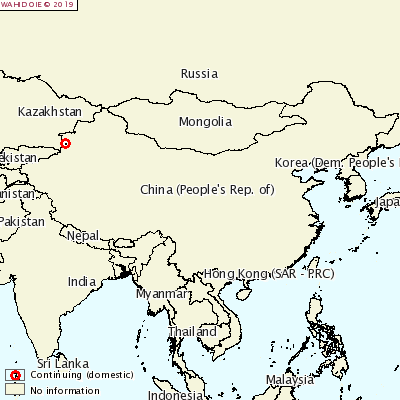First case of Lumpy skin disease in China
On 26 August 2019, Dr Zhang Zhongqui, Director General, China Animal Disease Control Centre, Veterinary Bureau, Ministry of Agriculture, Beijing, People's Republic of China notified to the OIE the first case of Lumpy skin disease in Qiongbola Village, Qiongbola Township, Qapqal Xibe Autonomous County, Ili Kazak Autonomous Prefecture, Xinjiang.
The date of start of the event was on 3 August 2019 and the outbreak was confirmed on 10 August 2019. The National Research center for exotic animal diseases, the National laboratory of China Animal Health and Epidemiology Center confirmed the positivity of 65 animals (cattle) by PCR test. All the animals were killed; the carcasses, by-products and waste were disposed of under official control.
The source of the outbreak or origin of infection is unknown and weekly follow-up reports will be submitted.
Lumpy skin disease is widespread and endemic throughout Africa, excluding Algeria, Morocco, Tunisia and Libya. Since 2013, LSD has swept throughout the Middle East (Israel, the Palestinian Autonomous Territories, Jordan, Lebanon, Kuwait, Saudi Arabia, Iraq, Iran, Oman, Yemen, United Arab Emirates and Bahrain). In 2013, LSD also spread to Turkey, where it is currently endemic. This was followed by outbreaks in Azerbaijan (2014), Armenia (2015) and Kazakhstan (2016), the southern Russian Federation (Dagestan, Chechnya, Krasnodar Kray and Kalmykia) and Georgia (2016). Since 2014, LSD has advanced into the northern part of Cyprus, Greece (2015), Bulgaria, the Former Yugoslav Republic of Macedonia, Serbia, Montenegro, Albania and Kosovo (2016).
The disease is having dramatic effects on rural livelihoods, which are strongly dependent on cattle, with significant income losses for affected farmers. Consequences are also devastating at national level since the presence of the disease has triggered strict trade restrictions. The risk of imminent contagion of neighboring countries is very high.
Lumpy skin disease is a vector-borne pox disease of domestic cattle and Asian water buffalo (Bubalus bubalis), and is characterized by the appearance of skin nodules; the morbidity rate is significantly lower in buffalo (1.6 %) than in cattle (30.8 %) (El-Nahas et al., 2011).
The principal vector is likely to vary between geographical regions and ecosystems. The common stable fly (Stomoxys calcitrans), the Aedes aegypti mosquito, and some African tick species of the Rhipicephalus and Amblyomma spp., have demonstrated ability to spread the LSDV.
Large-scale vaccination is the most effective way of limiting the spread of the disease. Effective vaccines against LSD exist and the sooner they are used the less severe the economic impact of an outbreak is likely to be.
References
© IZSAM
|
|
Istituto Zooprofilattico Sperimentale
dell'Abruzzo e del Molise "G. Caporale"
Campo Boario | 64100 TERAMO | ITALIA
Telefono 0039.0861.3321 | Fax 0039.0861.332251
e-mail: archivioeprotocollo@izs.it
Posta elettronica certificata: protocollo@pec.izs.it
Partita IVA: 00060330677
Codice Fiscale: 80006470670



